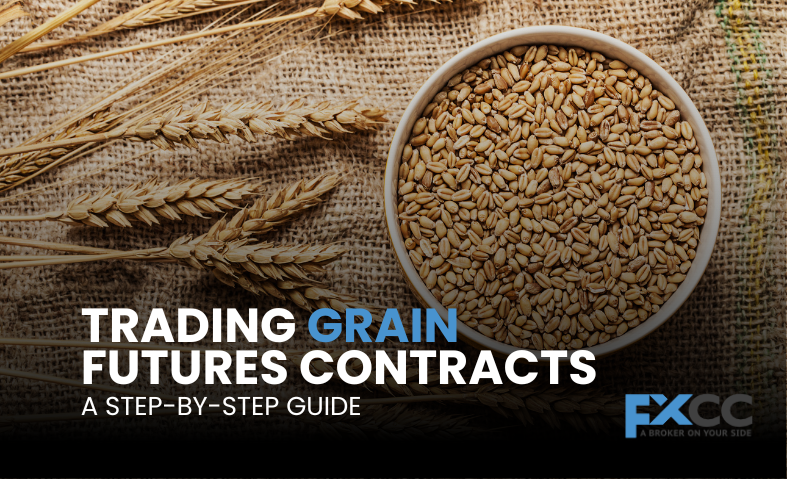Grain futures trading is a fascinating and rewarding way to engage with the agricultural market. These contracts enable participants to buy or sell specific grains, such as wheat, corn, or soybeans, at a set price on a future date. Farmers, traders, and investors use these contracts for various purposes, including hedging risks and speculating on market movements. If you’re new to this form of trading, this guide will walk you through the essentials in simple steps.
What Are Grain Futures?
Grain futures are standardized agreements to trade a specific quantity of a grain at a fixed price on a predetermined date. These contracts are traded on exchanges like the Chicago Board of Trade (CBOT). They allow traders to speculate on price changes or protect against risks like price volatility. Farmers might use futures to secure a good selling price for their crops, while speculators aim to profit from market movements.

Unlike physical trading, grain futures don’t always involve delivering or receiving the actual grain. Instead, most contracts are settled in cash before the delivery date, based on the price difference from the initial agreement.
Why Trade Grain Futures?
Grain futures are popular because they serve multiple purposes. For farmers and agribusinesses, these contracts reduce the risk of fluctuating prices by locking in a future selling price. This provides stability in an otherwise unpredictable market.
For traders and investors, grain futures present a chance to profit from price changes. For example, if you believe wheat prices will rise in the next few months, you can buy a futures contract now and potentially sell it later at a higher price.
Grain futures also offer diversification. Since these markets are influenced by unique factors like weather, government policies, and global demand, they can help balance a portfolio that might otherwise focus on stocks, bonds, or other traditional investments.
Step 1: Learn the Basics
Before jumping in, it’s essential to understand how grain futures work. Start by researching the common grains traded in futures markets, such as wheat, corn, and soybeans. Each of these has unique characteristics and price drivers.
For example, wheat prices can be influenced by droughts or geopolitical events in key producing regions. Corn prices might depend on demand for animal feed or ethanol production. Soybeans are heavily impacted by global trade policies and weather patterns. Understanding these factors will give you a foundation for making informed decisions.
Step 2: Choose a Reliable Trading Platform
To trade grain futures, you need access to a trading platform or brokerage that specializes in futures markets. These platforms act as intermediaries, connecting you to exchanges where futures are bought and sold.
When selecting a platform, look for one with a user-friendly interface, reliable customer support, and transparent fees. Some platforms also offer educational resources, like webinars or tutorials, which can be helpful if you’re new to trading.
Step 3: Open a Brokerage Account
After choosing your platform, you’ll need to open a brokerage account. This process involves providing personal information, verifying your identity, and depositing funds to start trading.
Ensure the brokerage firm you choose is reputable and registered with the relevant regulatory bodies. Once your account is set up, you can access live market data, analyze price trends, and place orders for grain futures contracts.
Step 4: Research the Market
Achieving success in grain futures trading depends on staying updated with market dynamics. Begin by following weather reports, as extreme conditions like droughts, floods, or frosts can significantly affect crop yields and prices.
Keep an eye on global demand as well. Factors like population growth, economic trends, and international trade agreements can shift demand for grains. For instance, an increase in biofuel production may drive up the demand for corn.
Government policies also play a crucial role. Subsidies, tariffs, or export bans can create ripples in the market, affecting grain prices worldwide.
Step 5: Develop a Trading Strategy
Having a clear trading strategy is vital for success. Many traders use methods like trend following, which involves analyzing market momentum and trading in the direction of the trend. Others rely on seasonal patterns, taking advantage of predictable price movements during planting or harvest seasons.
Risk management is equally important. Decide in advance how much you’re willing to risk on each trade and stick to your plan. Doing so reduces the likelihood of impulsive decisions that might result in losses.
Step 6: Start Small
If you’re a beginner, it’s wise to start with small trades to minimize risk. Practice using demo accounts provided by some trading platforms to gain confidence without financial exposure. Gradually increase your position sizes as you gain experience and refine your strategy.
Step 7: Monitor and Adjust
Once you start trading, continuously monitor your positions and market conditions. Grain markets are dynamic and influenced by a variety of factors. Always be ready to adapt your strategies as fresh insights emerge.
Leverage trading tools and analytics offered by your platform to stay ahead. Indicators like moving averages, volume analysis, and price patterns can provide valuable insights into market trends.

Grain futures trading offers an exciting opportunity to engage with the agricultural market, whether for hedging risks or seeking profits. By understanding the basics, choosing the right platform, and staying informed, you can navigate this market with confidence. Remember to start small, manage risks, and continually refine your approach as you gain experience. With dedication and a strategic mindset, trading grain futures can become a rewarding venture.


